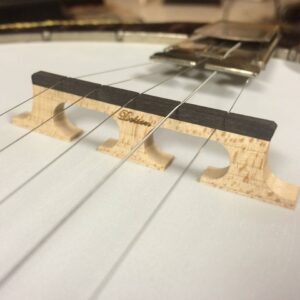Setting the intonation on a banjo or finding exactly where your banjo bridge should be located on the banjo head is something that should be checked. Changing strings, the action of your banjo that can change with the weather, and many other things can affect the banjo’s ability to play in tune.
By Richie Dotson
The banjo uses a “floating Bridge” system, which means that the bridge is held in place only by the string’s down-pressure against it. This works well for the banjo, but if the bridge gets moved, needs to be replaced or the banjo doesn’t note correctly when you are playing in the upper register, then the chances are good that the banjo bridge needs to be placed in the correct location, and here is how to do that:
What you will need:
A new set of strings on your banjo.
A yard stick
A fine-point pin.
A working, reasonably nice, electronic tuner.
Here is the whole process from beginning to end:
1, Start by making sure you have new strings and that all your machine heads, neck and all other fasteners are tight or properly adjusted.
2, Measure the distance from the leading edge of the nut (the edge where the fingerboard starts) to the top, dead center of the 12th fret. Use a yardstick and mark the 12th fret location on the yardstick with a fine-point pen.
3, Hold the edge of the yardstick’s beginning edge on the top, dead center of the 12th fret and place the bridge under the strings (under moderate tension) and move the bridge to the point where it’s leading edge (the edge closest to the fingerboard) is right on the mark you made.
4, Carefully scoot the bridge back (toward the tailpiece) 3/64″ (three, sixty fourths of an inch)
5, With your tuner, tune all the open strings to correct pitch and double check before moving to the next step.
6, Using only the 3rd string as a guide, play that string open, once again making sure it is registering “G” on your tuner with the banjo in your lap in the playing position.
7, With the banjo in the same position, fret the 3rd string at the 12th fret. If the tuner registers “G” you are done.
If the tuner registers something flat of G (lower) you need to gently scoot the bridge 1/16″ (one sixtieth of an inch) closer to the finger board, keeping it perpendicular to the strings and repeat steps 5 through 7.
If the tuner registers something sharp of G (higher) you need to gently scoot the bridge 1/16″ (one sixteenth of an inch) closer to the tailpiece keeping it perpendicular to the strings and repeat steps 5 through 7.
If your tuner isn’t picking up any differences between these 1/16″ bridge movements you should check to make sure it is working properly. It may be time for batteries or for a better tuner.
Check out this video that covers this subject quite nicely.
Thanks for reading,
Richie Dotson

